Related Research Articles

Simon bar Kokhba or Simon ben Koseba, commonly referred to simply as Bar Kokhba, was a Jewish military leader in Judea. He lent his name to the Bar Kokhba revolt, which he initiated against the Roman Empire in 132 CE. Though they were ultimately unsuccessful, Bar Kokhba and his rebels did manage to establish and maintain a Jewish state for about three years after beginning the rebellion. Bar Kokhba served as the state's leader, crowning himself as nasi. Some of the rabbinic scholars in his time imagined him to be the long-expected Messiah of Judaism. In 135, Bar Kokhba was killed by Roman troops in the fortified town of Betar. The Judean rebels who remained after his death were all killed or enslaved within the next year, and their defeat was followed by a harsh crackdown on the Judean populace by the Roman emperor Hadrian.

Samaria is the Hellenized form of the Hebrew name Shomron, used as a historical and biblical name for the central region of Israel, bordered by Judea to the south and Galilee to the north. The region is known to the Palestinians in Arabic under two names, Samirah, and Mount Nablus.

Qumran is an archaeological site in the West Bank managed by Israel's Qumran National Park. It is located on a dry marl plateau about 1.5 km (1 mi) from the northwestern shore of the Dead Sea, about 10 km (6 mi) south of the historic city of Jericho, and adjacent to the modern Israeli settlement and kibbutz of Kalya.
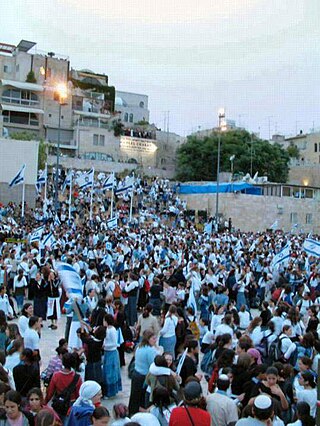
Religious Zionism is an ideology that views Zionism as a fundamental component of Orthodox Judaism. Its adherents are also referred to as Dati Leumi, and in Israel, they are most commonly known by the plural form of the first part of that term: Datiim. The community is sometimes called 'Knitted kippah', the typical head covering worn by male adherents to Religious Zionism.
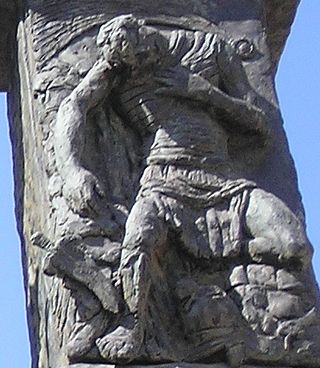
The Bar Kokhba revolt was a large-scale armed rebellion initiated by the Jews of Judea, led by Simon bar Kokhba, against the Roman Empire in 132 CE. Lasting until 135 or early 136, it was the third and final escalation of the Jewish–Roman wars. Like the First Jewish–Roman War and the Second Jewish–Roman War, the Bar Kokhba revolt resulted in a total Jewish defeat; Bar Kokhba himself was killed by Roman troops at Betar in 135 and the Jewish rebels who remained after his death were all killed or enslaved within the next year.
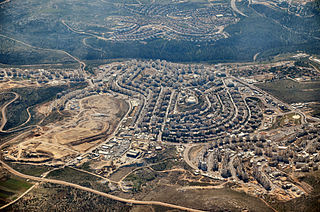
Modi'in Illit is a Haredi Jewish-Israeli settlement organized as a city council in the West Bank, situated midway between Jerusalem and Tel Aviv.

Emmaus is a town mentioned in the Gospel of Luke of the New Testament. Luke reports that Jesus appeared, after his death and resurrection, before two of his disciples while they were walking on the road to Emmaus.
There exists a consensus among scholars that the language of Jesus and his disciples was Aramaic. Aramaic was the common language of Judea in the first century AD. The villages of Nazareth and Capernaum in Galilee, where Jesus spent most of his time, were Aramaic-speaking communities. Jesus probably spoke a Galilean variant of the language, distinguishable from that of Jerusalem. Based on the symbolic renaming or nicknaming of some of his apostles it is also likely that Jesus and at least one of his apostles knew enough Koine Greek to converse with those not native to Judea. It is reasonable to assume that Jesus was well versed in Hebrew for religious purposes.

The Jewish–Roman wars were a series of large-scale revolts by the Jews of Judaea and the Eastern Mediterranean against the Roman Empire between 66 and 135 CE. The First Jewish–Roman War and the Bar Kokhba revolt were nationalist rebellions, striving to restore an independent Judean state, while the Kitos War was more of an ethno-religious conflict, mostly fought outside the province of Judaea. As a result, there is variation in the use of the term "Jewish-Roman wars." Some sources exclusively apply it to the First Jewish-Roman War and the Bar Kokhba revolt, while others include the Kitos War as well.

Usha was an ancient Jewish town in the western part of Galilee. It was identified in the late 19th century by Victor Guérin, who found the ruins on which the Arab village of Hawsha was built.

Emor is the 31st weekly Torah portion in the annual Jewish cycle of Torah reading and the eighth in the Book of Leviticus. The parashah describes purity rules for priests, recounts the holy days, describes the preparations for the lights and bread in the sanctuary, and tells the story of a blasphemer and his punishment. The parashah constitutes Leviticus 21:1–24:23. It has the most verses of any of the weekly Torah portions in the Book of Leviticus, and is made up of 6,106 Hebrew letters, 1,614 Hebrew words, 124 verses and 215 lines in a Torah Scroll.
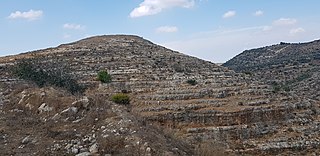
Khirbet Tibnah, is located on the West Bank, between the villages Deir Nidham and Nabi Salih.
Judaism has teachings and guidance for its adherents through the Hebrew Bible and rabbinic literature relating to the notion and concept of peace. The precepts of peacefulness and compassion are paramount in Judaism, Judaism also contains a number of doctrines which eschew violence. However, while Judaism condemns normative violence, it is not categorically pacifist.
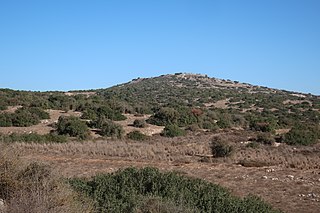
Tell ej-Judeideh is a tell in modern Israel, lying at an elevation of 398 metres (1,306 ft) above sea-level. The Arabic name is thought to mean, "Mound of the dykes." In Modern Hebrew, the ruin is known by the name Tell Goded.
The Baladi-rite Prayer is the oldest known prayer-rite used by Yemenite Jews, transcribed in a prayer book known as a tiklāl in Yemenite Jewish parlance. "Baladi", as a term applied to the prayer-rite, was not used until prayer books arrived in Yemen in the Sephardic-rite.

Yemenite scrolls of the Law containing the Five Books of Moses represent one of three authoritative scribal traditions for the transmission of the Torah, the other two being the Ashkenazi and Sephardic traditions that slightly differ. While all three traditions purport to follow the Masoretic traditions of Aaron ben Moses ben Asher, slight differences between the three major traditions have developed over the years. Biblical texts proofread by ben Asher survive in two extant codices, the latter said to have only been patterned after texts proofread by Ben Asher. The former work, although more precise, was partially lost following its removal from Aleppo in 1947.

Paleo-Hebrew Leviticus Scroll, known also as 11QpaleoLev, is an ancient text preserved in one of the Qumran group of caves, and which provides a rare glimpse of the script used formerly by the Israelites in writing Torah scrolls during pre-exilic history. The fragmentary remains of the Torah scroll is written in the Paleo-Hebrew script and was found stashed away in cave no. 11 at Qumran, showing a portion of Leviticus. The scroll is thought to have been penned by the scribe between the late 2nd century BCE to early 1st century BCE, while others place its writing in the 1st century CE.
Kefar Shiḥlayim, also Kfar Shiḥlim, Kfar Shahliim and Kfar Shiḥlaya, a place name compounded of the word "Kefar" (village) plus a denominative, was a Jewish town in the Judean Lowlands during the Second Temple period. The town is mentioned several times in Rabbinic literature, viz., the Babylonian Talmud, the Jerusalem Talmud and in Midrash Rabba, and is thought to have been destroyed during the Bar Kokhba revolt, alongside the villages of Bish and Dikrin, although later resettled.

The Bar Kokhba refuge caves are natural caves used for shelter by Jewish refugees during the later phases of the Bar Kokhba revolt. Most of the refuge caves were located in the Judaean Desert, nestled within steep cliffs far away from settlements, many overlooking the Dead Sea and the Jordan Valley. Some were also found in ravines flowing into the Dead Sea, while others were nestled within the Judaean Mountains. Unlike the other two hideout systems used by the rebels, the man-made rock-cut hiding complexes, and the hard-to-reach cliff shelters which often contain hewn installations, the refuge caves remained largely untouched by human intervention.
References
- 1 2 3 4 5 6 Tsafrir, Yoram; Zissu, Boaz (2002). The Roman and Byzantine Near East (3 ed.). Portsmouth, Rhode Island. pp. 6–36. ISBN 978-1887829496.
- ↑ "החיפושים אחר בר כוכבא : פרשת התגליות במערות מדבר יהודה ואיגרותיו של מנהיג המרד נגד רומא / יגאל ידין .. | ספר | ידין, יגאל, 1917-1984 | הספרייה הלאומית". www.nli.org.il (in Hebrew). Retrieved 2024-06-09.
- ↑ "אוסף תעודות ארמיות, עבריות ונבטיות ממדבר יהודה וחומר קרוב : שני כרכים - התעודות (א') ופליאוגרפיה וקונקורדנציה (ב') : עדה ירדני : 965-350-083-X : magnespress.co.il : Books". www.magnespress.co.il. Retrieved 2024-06-09.
- ↑ "מרד בר כוכבא : מחקרים חדשים / העורכים אהרן אופנהיימר, אוריאל רפפורט | ספר | Rappaport, Aharon | Rappaport, Aharon ;Oppenheimer, Aharon, 1940-2022 ;רפפורט, אוריאל, 1935-2019 ;Yad Yitsḥaḳ Ben-Tsevi | הספרייה הלאומית". www.nli.org.il (in Hebrew). Retrieved 2024-06-09.
- ↑ "מרד בר-כוכבא". kotar.cet.ac.il. Retrieved 2024-06-09.
- ↑ "Jerusalem Talmud Berakhot". www.sefaria.org. Retrieved 2024-06-09.
- ↑ "Eikhah Rabbah 1:51". www.sefaria.org. Retrieved 2024-06-09.
- ↑ Klein, Shmuel (1938). ספר הישוב : אוצר הידיעות והרשומות הכתובות והזכרונות, שנשתמרו בישראל ובעמים בלשון העברית ובשאר לשונות על ישוב ישראל ותולדותיו בארצו מימי חרבן בית שני עד ראשית ההתישבות החדשה בימי חבת ציון. ירושלים : [מוסד ביאליק ע"י דביר].
- ↑ כהן, חיים. "היישוב היהודי בצפון הר חברון משלהי ימי הבית השני ועד מרד בר-כוכבא M.A."
{{cite journal}}: Cite journal requires|journal=(help) - ↑ www.israelhayom.co.il https://www.israelhayom.co.il/article/317879 . Retrieved 2024-06-09.
{{cite web}}: Missing or empty|title=(help)